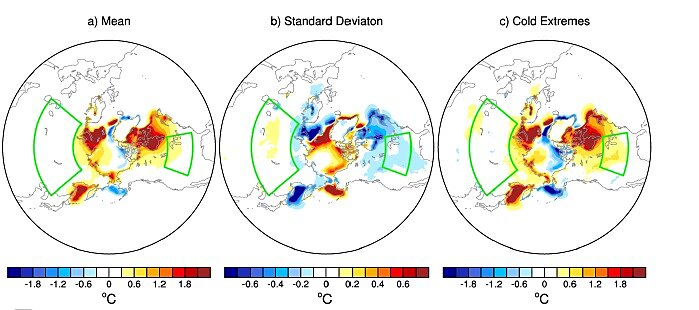Global Science Report is a feature from the Center for the Study of Science, where we highlight one or two important new items in the scientific literature or the popular media. For broader and more technical perspectives, consult our monthly “Current Wisdom.”
—
Although it’s a favorite headline as people shiver during the coldest parts of the winter, global warming is almost assuredly not behind your suffering (the “warming” part of global warming should have clued you in on this).
But, some folks steadfastly prefer the point of view that all bad weather is caused by climate change.
Consider White House Office of Science and Technology Policy (OSTP) head John Holdren. During the depth of the January 2014 cold outbreak (and the height of the misery) that made “polar vortex” a household name, OSTP released a video featuring Holdren telling us that “the kind of extreme cold being experienced by much of the United States as we speak, is a pattern that we can expect to see with increasing frequency as global warming continues.”
At the time we said “not so fast,” pointing out that there were as many (if not more) findings in the scientific literature that suggested that either a) no relationship exists between global warming and the weather patterns giving rise to mid-latitude cold outbreaks, or b) the opposite is the case (global warming should lead to fewer and milder cold air outbreaks).
The Competitive Enterprise Institute even went as far as to request a formal correction from the White House. The White House responded by saying that the video represented only Holdren’s “personal opinion” and thus no correction was necessary. CEI filed a FOIA request, and after some hemming and hawing, the White House OSTP finally, after a half-hearted search, produced some documents. Unhappy with this outcome, CEI challenged the effort and just this past Monday, a federal court, questioning whether the OSTP acted in “good faith,” granted CEI’s request for discovery.
In the meantime, the scientific literature on this issue continues to accumulate. When a study finds a link between human-caused global warming and winter misery, it makes headlines somewhere. When it doesn’t, that somewhere is usually reduced to here.
Case in point: Last week, Washington Post’s Capital Weather Gang published a piece by Jason Samenow that highlighted a pair of new findings that suggested that global warming was leading to more blizzards along the East Coast. The mechanism, favored by the global-warming-is-making-cold/blizzards-worse crowd is that Arctic warming, enhanced by melting sea ice there, is causing the curves (i.e., ridges and troughs) in the jet stream to become bigger, and thus slower. This “locks in” a particular weather pattern and can allow cold air to drop further southward as well as set up condition necessary for big snow storms. To us, this seemed more a case of natural variability than global warming, but we suppose beauty is in the eye of the beholder.
But what you haven’t read in the Washington Post (or anywhere else for that matter), is that an even newer paper has just been published by scientists (including Martin Hoerling) at NOAA’s Earth System Research Laboratory that basically demonstrates that global warming and Arctic sea ice loss should, according to climate models, lead to warmer winter temperatures, less temperature variability, and milder cold air outbreaks. This is basically the opposite conclusion from the one preferred and disseminated by Holdren et al.
From the paper’s abstract:
The emergence of rapid Arctic warming in recent decades has coincided with unusually cold winters over Northern Hemisphere continents. It has been speculated that this “Warm Arctic, Cold Continents” trend pattern is due to sea ice loss. Here we use multiple models to examine whether such a pattern is indeed forced by sea ice loss specifically, and by anthropogenic forcing in general. While we show much of Arctic amplification in surface warming to result from sea ice loss, we find that neither sea ice loss nor anthropogenic forcing overall to yield trends toward colder continental temperatures. An alternate explanation of the cooling is that it represents a strong articulation of internal atmospheric variability, evidence for which is derived from model data, and physical considerations. Sea ice loss impact on weather variability over the high latitude continents is found, however, characterized by reduced daily temperature variability and fewer cold extremes.
They were even more direct in paper’s conclusion:
We…showed that sea ice loss impact on daily weather variability over the high latitude continents consists of reduced daily temperature variability and fewer cold extremes indicating that the enhanced occurrences of cold spells during recent winters (e.g., Cohen et al. 2014) are not caused by sea ice loss.
This is pretty emphatic. Global warming results in warmer, less variable winters in North America (Figure 1).
Figure 1. Modeled change in winter mean temperature (left), daily temperature variability (middle), and temperature on the coldest 10 percent of the days (right) as a result of decline in Arctic sea ice. (source: Sun et al., 2016).
Now, if only our government’s “top scientist” were paying attention.
Reference:
Sun, L., J. Perlwitz, and M. Hoerling, 2016. What Caused the Recent “Warm Arctic, Cold Continents” Trend Pattern in Winter Temperatures? Geophysical Research Letters, doi: 10.1002/2016GL069024.

